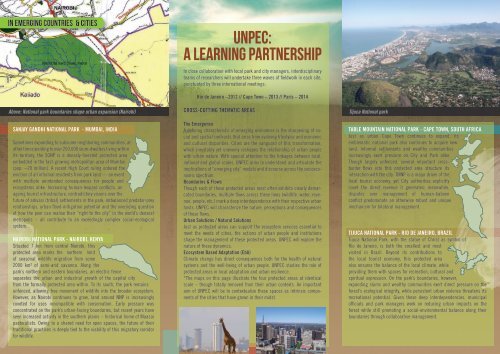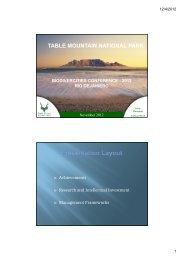Urban National Parks In Emerging Countries & Cities - UPA - Urban ...
Urban National Parks In Emerging Countries & Cities - UPA - Urban ...
Urban National Parks In Emerging Countries & Cities - UPA - Urban ...
Create successful ePaper yourself
Turn your PDF publications into a flip-book with our unique Google optimized e-Paper software.
<strong>In</strong> <strong>Emerging</strong> <strong>Countries</strong> & <strong>Cities</strong><br />
SANJAY GANDHI NATIONAL PARK - MUMBAI, INDIA<br />
Sometimes expanding to subsume neighboring communities, at<br />
other times yielding to over 200,000 slum-dwellers living within<br />
its territory, the SGNP is a densely-forested protected area<br />
embedded in the fast-growing metropolitan area of Mumbai<br />
(pop. ~20 million). A recent High Court ruling ordered the<br />
eviction of all informal residents from park land — an event<br />
with multiple unintended consequences for people and<br />
ecosystems alike. <strong>In</strong>creasing human-leopard conflicts, an<br />
ageing tourist infrastructure, contradictory visions over the<br />
future of adivasi (tribal) settlements in the park, imbalanced predator-prey<br />
relationships, urban flood-mitigation potential and the overriding question<br />
of how the poor can realise their “right to the city” in the world’s densest<br />
metropolis – all contribute to an exceedingly complex social-ecological<br />
system.<br />
NAIROBI NATIONAL PARK - NAIROBI, KENYA<br />
Situated 7 km from central Nairobi, this<br />
protected area marks the northern limit<br />
of seasonal wildlife migration from some<br />
2000 km² of semi-arid savanna. Along the<br />
park’s northern and eastern boundaries, an electric fence<br />
separates the urban and industrial growth of the capital city<br />
from the formally protected area within. To its south, the park remains<br />
unfenced, allowing free movement of wildlife into the broader ecosystem.<br />
However, as Nairobi continues to grow, land around NNP is increasingly<br />
coveted for uses incompatible with conservation. Early pressure was<br />
concentrated on the park’s urban-facing boundaries, but recent years have<br />
seen increased activity in the southern plains – historical home of Maasai<br />
pastoralists. Owing to a shared need for open spaces, the future of their<br />
traditional practices is deeply tied to the viability of this migratory corridor<br />
for wildlife.<br />
UNPEC:<br />
A Learning Partnership<br />
<strong>In</strong> close collaboration with local park and city managers, interdisciplinary<br />
teams of researchers will undertake three waves of fieldwork in each site,<br />
punctuated by three international meetings:<br />
Rio de Janeiro –2012 // Cape Town – 2013 // Paris – 2014<br />
Above: <strong>National</strong> park boundaries shape urban expansion (Nairobi) CROSS-CUTTING THEMATIC AREAS<br />
Tijuca <strong>National</strong> park<br />
The Emergence<br />
A defining characteristic of emerging economies is the sharpening of social<br />
and spatial contrasts that arise from evolving lifestyles and economic<br />
and cultural disparities. <strong>Cities</strong> are the vanguard of this transformation,<br />
which inevitably yet unevenly reshapes the relationship of urban people<br />
with urban nature. With special attention to the linkages between local,<br />
national and global scales, UNPEC aims to understand and articulate the<br />
implications of “emerging city” models and discourse across the socioeconomic<br />
spectrum.<br />
Boundaries & Flows<br />
Though each of these protected areas most often exhibits clearly demarcated<br />
boundaries, multiple flows across these lines (wildlife, water, revenue,<br />
people, etc.) mark a deep interdependence with their respective urban<br />
hosts. UNPEC will characterize the nature, perceptions and consequences<br />
of these flows.<br />
<strong>Urban</strong> Solutions / Natural Solutions<br />
Just as protected areas can support the ecosystem services essential to<br />
meet the needs of cities, the actions of urban people and institutions<br />
shape the management of these protected areas. UNPEC will explore the<br />
nature of these dynamics.<br />
Ecosystem Based Adaptation (EbA)<br />
Climate change has direct consequences both for the health of natural<br />
systems and the well-being of urban people. UNPEC studies the role of<br />
protected areas in local adaptation and urban resilience.<br />
*The maps on this page illustrate the four protected areas at identical<br />
scale – though totally removed from their urban contexts. An important<br />
aim of UNPEC will be to contextualize these spaces as intrinsic components<br />
of the cities that have grown in their midst.<br />
TABLE MOUNTAIN NATIONAL PARK - CAPE TOWN, SOUTH AFRICA<br />
Just as urban Cape Town continues to expand, its<br />
emblematic national park also continues to acquire new<br />
land. <strong>In</strong>formal settlements and wealthy communities<br />
increasingly exert pressure on City and Park alike.<br />
Though largely unfenced, several important crossborder<br />
flows into this protected area structure its<br />
interaction with the city: TMNP is a major driver of the<br />
local tourist economy, yet City authorities explicitly<br />
covet the direct revenue it generates; meanwhile,<br />
disputes over management of human-baboon<br />
conflict predominate an otherwise robust and unique<br />
mechanism for bilateral management.<br />
TIJUCA NATIONAL PARK - RIO DE JANEIRO, BRAZIL<br />
Tijuca <strong>National</strong> Park, with the statue of Christ as symbol of<br />
Rio de Janeiro, is both the smallest and most<br />
visited in Brazil. Beyond its contributions to<br />
the local tourist economy, this protected area<br />
also ensures the balance of the local climate, while<br />
providing them with spaces for recreation, cultural and<br />
spiritual expression. On the park’s boundaries, however,<br />
expanding slums and wealthy communities exert direct pressure on the<br />
forest’s ecological integrity, while persistent urban violence threatens its<br />
recreational potential. Given these deep interdependencies, municipal<br />
officials and park managers work on reducing urban impacts on the<br />
forest while still promoting a social-environmental balance along their<br />
boundaries through collaborative management.




